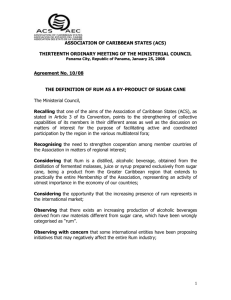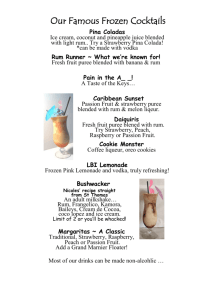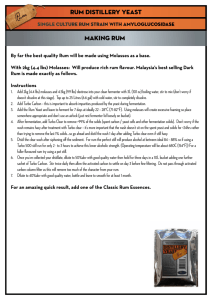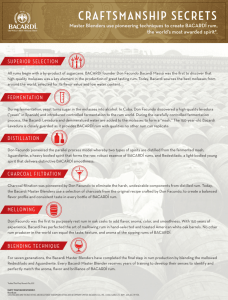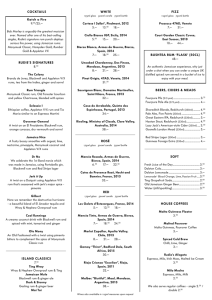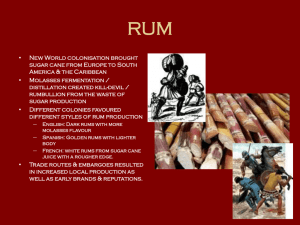CARIBBEAN SPIRIT
advertisement
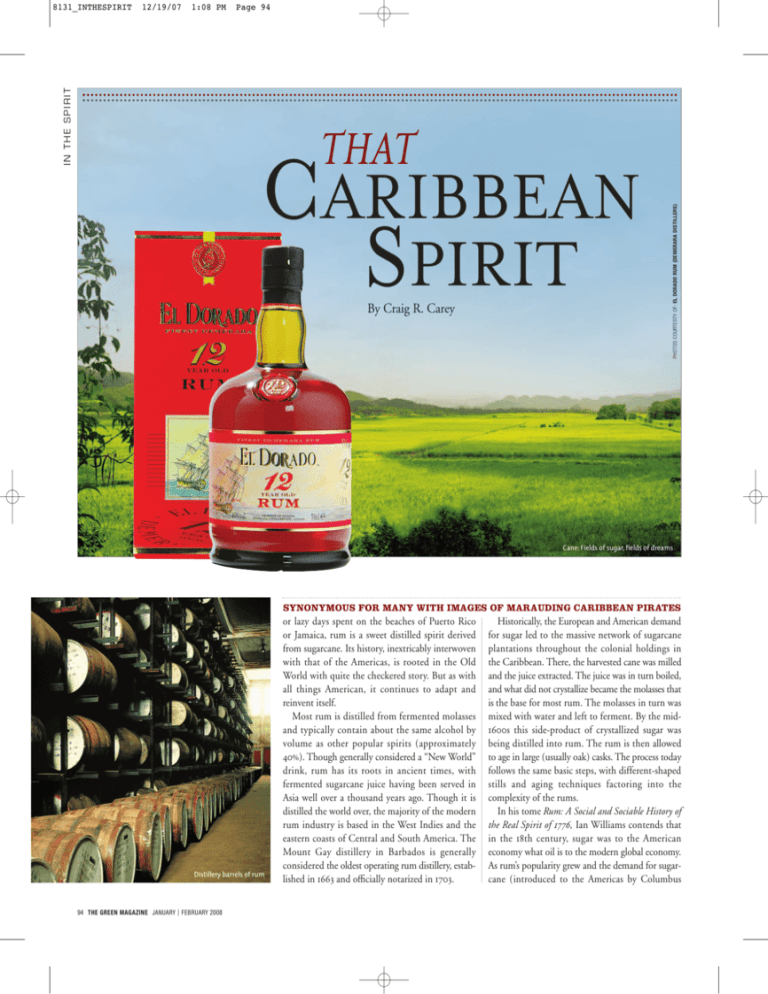
12/19/07 1:08 PM IN THE SPIRIT 8131_INTHESPIRIT Page 94 CARIBBEAN SPIRIT By Craig R. Carey PHOTOS COURTESTY OF: EL DORADO RUM (DEMERARA DISTILLERS) THAT Cane: Fields of sugar, fields of dreams SYNONYMOUS FOR MANY WITH IMAGES OF MARAUDING CARIBBEAN PIRATES Distillery barrels of rum 94 THE GREEN MAGAZINE JANUARY | FEBRUARY 2008 or lazy days spent on the beaches of Puerto Rico or Jamaica, rum is a sweet distilled spirit derived from sugarcane. Its history, inextricably interwoven with that of the Americas, is rooted in the Old World with quite the checkered story. But as with all things American, it continues to adapt and reinvent itself. Most rum is distilled from fermented molasses and typically contain about the same alcohol by volume as other popular spirits (approximately % ). Though generally considered a “New World” drink, rum has its roots in ancient times, with fermented sugarcane juice having been served in Asia well over a thousand years ago. Though it is distilled the world over, the majority of the modern rum industry is based in the West Indies and the eastern coasts of Central and South America. The Mount Gay distillery in Barbados is generally considered the oldest operating rum distillery, established in and officially notarized in . Historically, the European and American demand for sugar led to the massive network of sugarcane plantations throughout the colonial holdings in the Caribbean. There, the harvested cane was milled and the juice extracted. The juice was in turn boiled, and what did not crystallize became the molasses that is the base for most rum. The molasses in turn was mixed with water and left to ferment. By the mids this side-product of crystallized sugar was being distilled into rum. The rum is then allowed to age in large (usually oak) casks. The process today follows the same basic steps, with different-shaped stills and aging techniques factoring into the complexity of the rums. In his tome Rum: A Social and Sociable History of the Real Spirit of 1776, Ian Williams contends that in the th century, sugar was to the American economy what oil is to the modern global economy. As rum’s popularity grew and the demand for sugarcane (introduced to the Americas by Columbus 8131_INTHESPIRIT 12/19/07 12:50 PM Page 95 ¿QUIÉN ERA BACARDI? for the first two centuries of its distillation akin to the light rums presently available on the market. in the West Indies and the American colonies, rum (“ron”) With this refined version of the molasses-distilled spirit, was considered a coarse drink that paled — Figuratively Don Facundo founded Bacardi & Company. speaking — in comparison to the haughty drinks of the El Dorado 15 year old rum The company fled Cuba for Puerto Rico in 1961 ahead of Old World. To resolve this issue, the Spanish crown put Castro’s troops, abandoning huge investments in distilling forth a reward to any distiller who could improve the basic equipment. In his book And a Bottle of Rum: A History of processes and end-product of rum. Many distillers the New World in Ten Cocktails, Wayne Curtis relates that contributed improvements to the overall process, and key “today, virtually all traces of Bacardi have been erased from among them was Don Facundo Bacardí Massó, a Spaniard Havana, like a Stalin-era apparatchik airbrushed out of a who settled in Cuba in the 1840s. Don Facundo experimented Soviet politburo photograph.” with many processes, including those used by American The Bacardí family and the Castro regime remain at odds whiskey distillers (such as charcoal filtering and cask-aging). over what is best for Cuba’s interests, both economically The end result was a smoother, far more palatable drink and socially. THE FIRST TIME I PLAYED THE “ MASTERS, I WAS SO NERVOUS I DRANK A BOTTLE OF RUM BEFORE I TEED OFF. I SHOT THE HAPPIEST 83 OF MY LIFE. — CHI CHI RODRIGUEZ ” El Dorado 21 year old rum in on his second American voyage) increased, so too did the slave trade in all its American markets. And while much is made of the Boston Tea Party, rum factored into the American colonial scene far more prominently (let us remember the Tea Party was not only a protest against the taxation of tea but also of molasses. The spirit was traded from Newfoundland to the Amazon delta, often in defiance of British laws forbidding spirit trade between colonies. Today, because most rum purchased and consumed in the us hails from Puerto Rico, Americans tend to be familiar with the lighter rums of that island (similar to those of Cuba, the Dominican Republic and other traditionally Spanish-speaking islands of the Caribbean). Light rums are less complex and less flavorful than dark rums, and as a result are most often used for mixing cocktails, much like vodka. Dark rums, more common in the English-speaking islands, retain more of their molasses heritage, are aged longer and are more complex. This complexity has garnered a whiskey-like loyalty among many drinkers — El Dorado at present is considered the finest of these aged rums. Other variants include a multitude of flavored rums (Malibu and Bacardi offer a bevy of fruit-flavored rums) and a wide selection of spiced rums (such as Captain Morgan). Casual bar denizens would already be familiar with the many rum cocktails such as the daiquiri, rum and Coke, piña coladas, and the recentlyfashionable-again mojito. The daiquiri, named for a region in Cuba, is comprised of rum, lime juice, and sugar, but like most drinks, the ratio of spirit to additional ingredients varies. A generic piña colada is a simple mix of light and dark rum, pineapple juice, and coconut cream (not coconut milk) garnished with fruit. The mojito is of Cuban origin and thought to be the successor of a similar drink concocted by English corsairs in the s using a crude forerunner of rum. A refreshing combination of mint, sugar, lime juice, club soda, and rum, the mojito migrated north after the repeal of the Volstead Act in and by the outbreak of World War ii was a staple of many bars and clubs. But in the years after the war, mojitos did not regain their initial popularity. Theories abound as to why (the onslaught of prepackaged drink mixes and the necessity of fresh mint leaves are among those espoused), but in the s the cocktail re-emerged in Miami restaurants serving neo-traditional Cuban cuisine. Its popularity has only increased since, and like most rum cocktails, variations abound. Fetch aft the rum, Darby! æ >Special thanks to Alastair Abrehart of Pusser’s Rum, Ian Lye of El Dorado Rum, and Susan Banet of Appleton Rum (Brown-Forman). WWW.THEGREENMAGAZINE.COM 95

